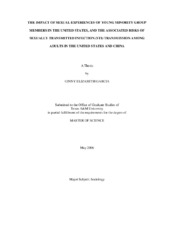| dc.contributor.advisor | Poston, Dudley L., Jr. | |
| dc.creator | Garcia, Ginny Elizabeth | |
| dc.date.accessioned | 2006-08-16T19:00:52Z | |
| dc.date.available | 2006-08-16T19:00:52Z | |
| dc.date.created | 2005-05 | |
| dc.date.issued | 2006-08-16 | |
| dc.identifier.uri | https://hdl.handle.net/1969.1/3732 | |
| dc.description.abstract | This thesis explores incidence rates of sexually transmitted infections (STIs)
among minority group teenagers in the United States and among adults aged 20-34 in the
U.S. and in China. The focus is on trends and patterns in the United States compared to
those in China. Research questions include whether or not the early onset of sexual
activity is directly related to the incidence of STI transmission among Americans. The
Chinese analysis enables addressing the question of whether or not a hidden epidemic
exists in China with regard to STI transmission rates. The thesis involves three separate
analyses including a comparative study of teens (age 15-19) and adults (age 20-44) in the
United States, a comparative study of adults aged 20-44 in the United States and China,
and a comparative analysis of urine-based results versus self-reported responses among
the Chinese adults. The use of logistic regression is employed in order to model the odds
of the risk of transmission among the different groups.
The results from this thesis indicate that early onset of sexual activity is indeed a
risk factor for young minority group members in the United States in terms of the
bacterial infections. The analysis of American adults revealed that women who have
college educations and who are not minority group members are at risk of contracting viral infections with more frequency. Finally, a hidden epidemic among Chinese women
was detected with respect to the bacterial infections.
It is important to study these trends within the U.S. and abroad in China for many
reasons. First and foremost, young adults are the most heavily impacted in the United
States. This population should be focused on as many of the infections discussed may
lead to lifelong difficulties (including infertility) if left untreated. Also, with respect to
China, a large proportion of those who are infected do not know they are. Again, these
infections may lead to many complications and Chinese women are at an increased risk
because many are infected unknowingly due to the behavior of their partner/spouse.
Finally, sexually transmitted infections amplify the transmission rates of HIV/AIDS and
should be studied specifically for this reason if none other. | en |
| dc.format.extent | 366785 bytes | en |
| dc.format.medium | electronic | en |
| dc.format.mimetype | application/pdf | |
| dc.language.iso | en_US | |
| dc.publisher | Texas A&M University | |
| dc.subject | Sexually Transmitted Infections | en |
| dc.subject | China | en |
| dc.subject | STI | en |
| dc.subject | Teenagers | en |
| dc.subject | United States | en |
| dc.title | The impact of sexual experiences of young minority group members in the United States, and the associated risks of sexually transmitted infection (STI) transmission among adults in the United States and China | en |
| dc.type | Book | en |
| dc.type | Thesis | en |
| thesis.degree.department | Sociology | en |
| thesis.degree.discipline | Sociology | en |
| thesis.degree.grantor | Texas A&M University | en |
| thesis.degree.name | Master of Science | en |
| thesis.degree.level | Masters | en |
| dc.contributor.committeeMember | McIntosh, William Alex | |
| dc.contributor.committeeMember | Sell, Jane | |
| dc.type.genre | Electronic Thesis | en |
| dc.type.material | text | en |
| dc.format.digitalOrigin | born digital | en |


